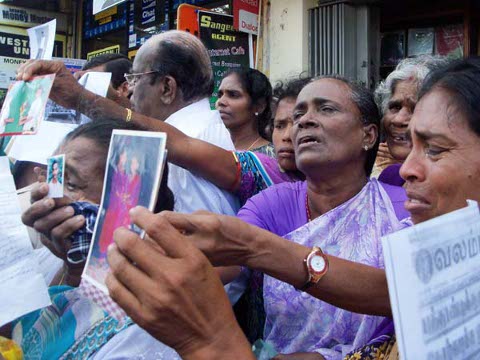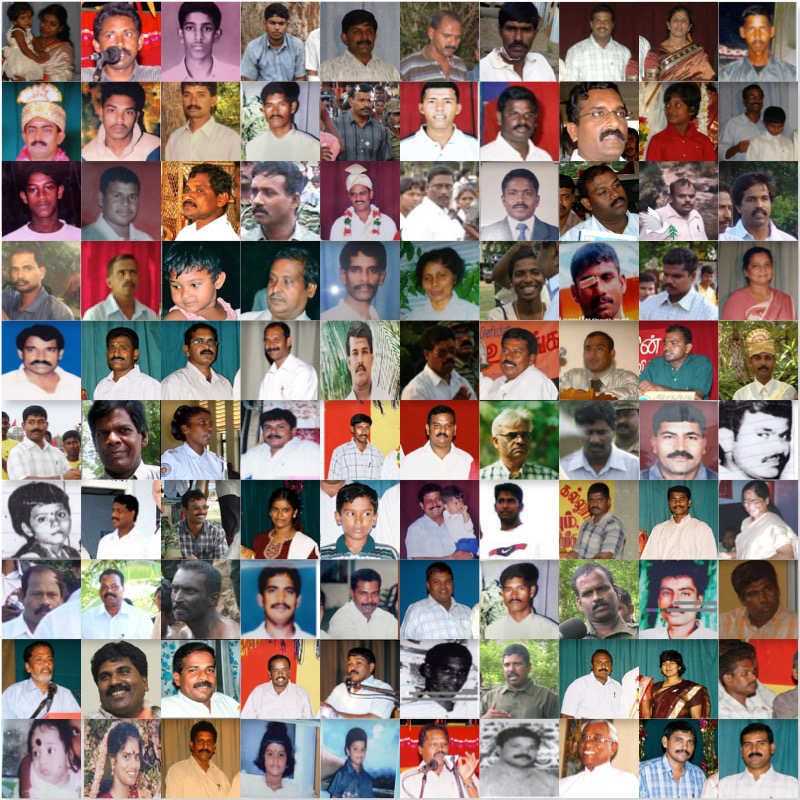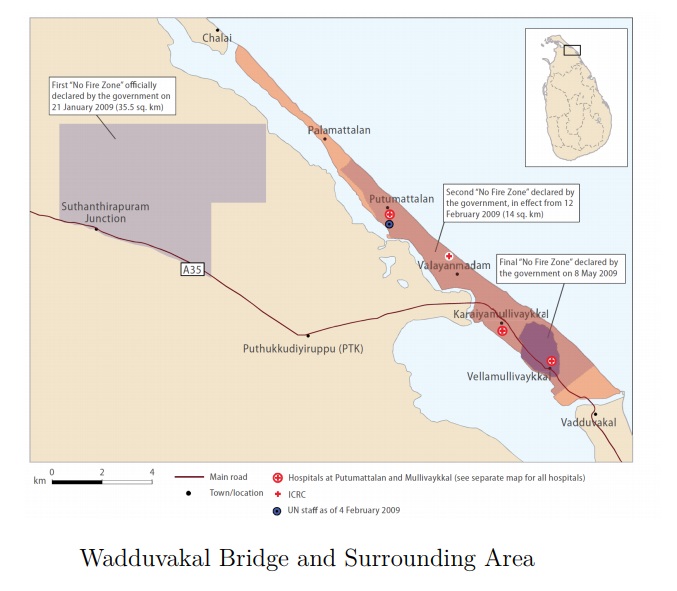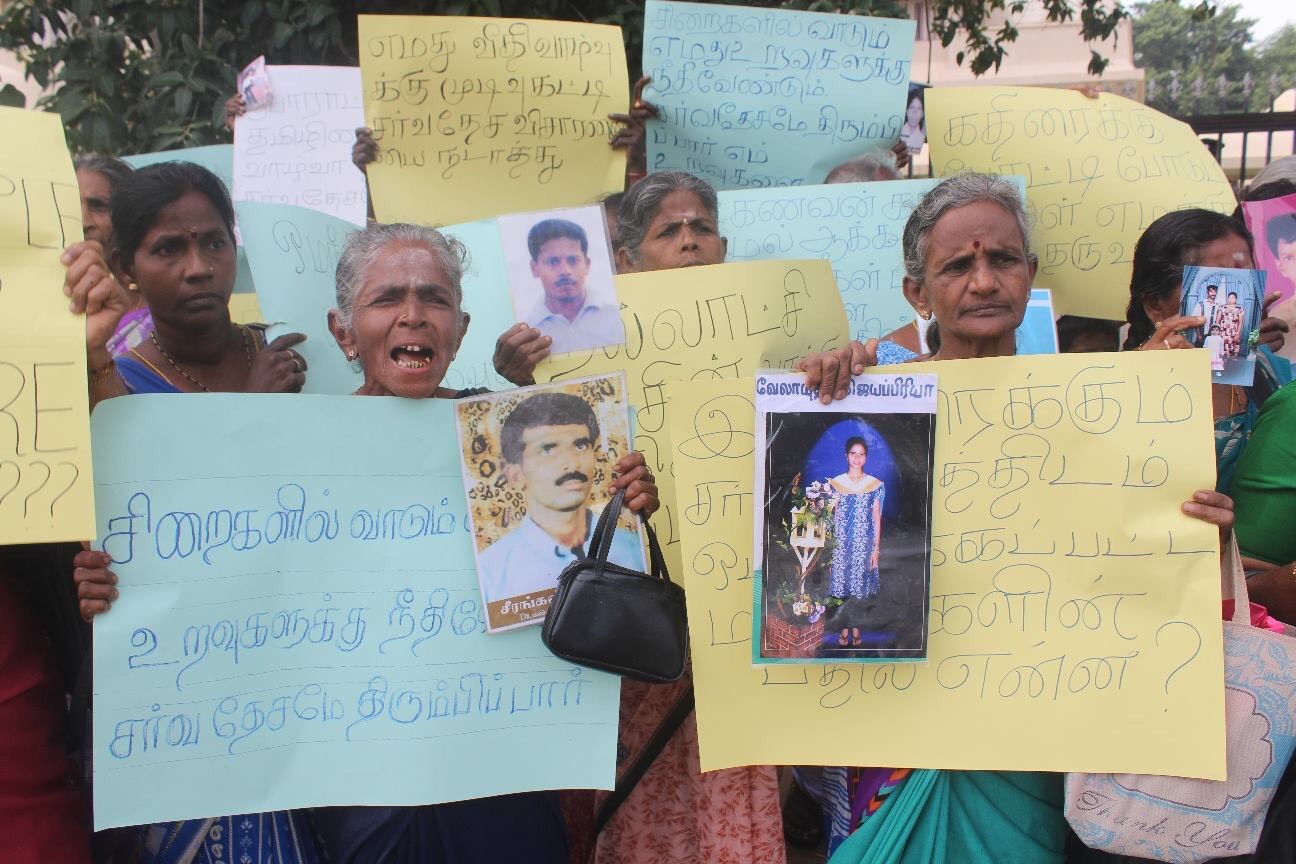HUMAN RIGHTS, IDPS AND REFUGEES, PEACE AND CONFLICT, POLITICS AND GOVERNANCE, POST-WAR, RECONCILIATION, VAVUNIYA
Surrendering and Disappearing: Where are they now?
05/05/2012

“Disappearance is far worse than death because when a person dies, when I know that, so and so is dead, the story ends and somehow or other we close the chapter. But when a person has disappeared, it is an eternal suffering.”
(A.Santhipali, before the LLRC at Jaffna on 12th November 2010)
In the controversial Commission of Inquiry on Lessons Learnt and Reconciliation, 53 LTTE cadres who surrendered during the final days of the war in May 2009 are alleged to have been disappeared and are reported to be under the category of ‘missing’. What happened to these 53 people? Their relatives and close kith and kin say that they were last seen and heard surrendering to the Sri Lankan Army.
In the LLRC report, many family members of former LTTE cadres have complained that their husbands, wives, sisters, brothers, sons and daughters have disappeared after they surrendered to the Sri Lankan security forces. These family members still await the return of their loved ones, not knowing whether they would ever return. Below is a quotation from the LLRC report where a wife complained to the commission about the disappearance of her husband and presented the tragic story, which she is forced to deal with every day.
“The wife of another former LTTE cadre appearing before the commission at the District Secretariat in Madu stated that on 16th May 2009 she and her three children had come to Mullaittivu from Mullaivaikkal. Her husband had not accompanied them but had joined them on 17th May 2009. On 18th May 2009, in the morning, he had surrendered to the Army at Mullattivu together with some important LTTE cadres (Elamparthy, Kumaran, Ruben, Babu and Velavan). They had surrendered accompanied by Farther Francis Joseph and had been taken away in a bus. She stated that she had not heard from him since then. The Commission made inquiries regarding Farther Francis Joseph from Farther Muralitharan the Parish Priest and Assistant Administrator of Madhu Church, and he stated that Farther Francis Joseph had been a political teacher of the LTTE and people had told him that Father Francis Joseph had been in the conflict area until the end with the LTTE and was supposed to have surrendered and since then his whereabouts were unknown.”
(Page: 111 of the LLRC in the Representations to the commission regarding alleged disappearances after surrender/arrest)
There are 18 such complaints lodged with the LLRC with regard to the 53 disappeared LTTE cadres, who surrendered. Their whereabouts are unknown to this day. Whether they are alive or dead is unknown and presents an extremely tragic and problematic context for their families, who still hope and wait for their return. During a visit this writer paid to Jaffna last January, she was confronted by a dramatist in Jaffna who narrated the sad story of many wives whose husbands have disappeared due to the war. The Jaffna dramatist whose name is Dev Annand had done research on the subject and had woven a drama based on real incidents. His words are still alive in my memory.
“In the Tamil culture, the wife has to wear red kunkuman (a pottuwa) on her forehead if she is married as a custom. But if the husband is dead, they cannot wear this as a ritual. So in the case of ‘missing’ husbands, women do not know whether to wear the kunkuma or not, and they are eternally getting criticized by the elders of their community for this: because those who believe that their husbands are dead, are telling them not to wear it, while the wife’s heart that still waits for the return of her husband wears the kunkuman as hope.”
When this writer contacted the Military Spokesperson, Brigadier Ruwan Wanigasuriya, and questioned him regarding these 53 LTTE cadres who have disappeared and inquired about what actually happened to them, Wanigasuriya stated that the army has appointed a commission called the Court of Inquiry headed by a Major General and also compromises of senior officers of the army to look into the findings of the LLRC report that are directly related to the army.
“This Court of Inquiry will look into all the findings concerning the military that are in the LLRC report, and under that, they will look into this issue as well and investigate into this matter. However, we have records of 27 LTTE cadres who deserted while they were hospitalized for various illnesses; and 13 other LTTE cadres who suffered natural deaths. A total of 11,995 people came to be rehabilitated in May 2009. This includes LTTE carders who surrendered during the war and LTTE cadres who surrendered while they were in the Internally Displaced Persons (IDP) camps. From this number, 10,874 LTTE cadres have been rehabilitated and reintegrated to society. From this lot, 655 cadres are with us at the rehabilitation centres now, and 187 are in custody at the Law Enforcement Authority for investigations due to the fact that there is evidence against them”, Wanigasuriya averred.
However, when pressed to answer about the 53 LTTE cadres that have disappeared, Wanigasuriya said that they could either belong to the 27 deserters or to the 13 LTTE cadres who suffered natural deaths and further added that the Sri Lankan army has given away all the LTTE cadres who were caught and surrendered in May 2009 (except for the 655 who are still at the rehabilitation centres) to the Prisons Department and the Sri Lankan Police Department.
During further investigations, this writer contacted the Prisons Department, Prisons Commissioner, A. Hapuarchi, who revealed that there are 500-600 LTTE cadres in the prisons of Jaffna, Vavuniya, Anuradapura, Magazine, Colombo, Bogambara, Batticaloa, Trincomalee, Negambo arrested under remand warrants. However, when this writer contacted the Police Spokesman Ajith Rohana regarding this matter he refused to comment saying that it is up to the Ministry of Defence.
Nevertheless, though the authorities keep passing the buck to each other (amidst themselves), the Tamil National Alliance (TNA) spokesman and Jaffna District Parliamentarian, Suresh Premachandran, stated that the Sri Lankan army was not only culpable for these 53 lives, but also for the hundreds of other who have disappeared without a trace in this country.
“The army is answerable for this. And it is not just 53, about 200 LTTE cadres surrendered to the army with Father Francis Joseph on that instance. And since then, up to today, no one knows anything about the whereabouts of those surrenders’. No one knows what happened to them and whether they are alive or dead still remains a question mark. The families of these people have not heard from them since. So the families have lost all communications with these surrendered LTTE cadres”, Premachandran added.
Speaking further Premachandran also revealed that in Menik Farm (after 2009) the army had taken away hundreds of boys and girls; and since then the relatives of these youths have not heard anything about their whereabouts. “They have gone missing. One of our TNA members has a list of more than 500 missing personalities who have disappeared from the Menik Farm”, Premachandran stated.
The LLRC report earned different kinds of reactions from the public. Ironically, even the people who were in disfavour of this report at first (and criticized the LLRC while declaring that it is partial) are now urging the government to implement the report as the government has accepted it. One such political activist is Dr. Vikramabahu Karunaratne. When questioned about the 53 individuals who are noted in the LLRC as ‘missing’ while they were in the custody and protection of the army, Karunaratne stated, “This has to be investigated and reported and action should be taken about this by the government. We heard of many similar situations where LTTE political prisoners have disappeared after they were taken into custody. The government is saying that they are rehabilitating, but they never tell us about where these rehabilitation centres are situated, or how many LTTE cadres are within their custody. And when the TNA MPs tried to visit these rehabilitation camps, the government denied access and did not allow them to visit the rehabilitation camps”.
Speaking further Karunaratne added that the process of rehabilitation is not indicated by the security forces or the government and further revealed that people have disappeared during the process of rehabilitation itself in Sri Lanka.
“We have received many reports from ex-LTTE cadres declaring that many carders disappeared during the process of rehabilitation and did not come out with them (once they were released)”, Karunaratne stated.
How does civil society respond to the disappearance of these 53 LTTE cadres? This writer spoke to a human rights activist who was closely monitoring violations of human rights in Sri Lanka during the time of the war. The activist spoke to this writer under terms of anonymity, and when questioned about these disappeared LTTE cadres and asked about what could have exactly happened to them, the activist revealed that they could either be killed, held in detention centres, or used as informants.
“Whether they are killed, held in detention centres or used as informants: either way it is illegal and wrong. Their family members should be allowed to see them. If they have done something wrong, then they should be legally charged,” he said.
Speaking further about the disappearance of the 53 individuals, this human rights activist stated, “Thousands of people have seen these people surrendering to the army with Father Francis Joseph. And therefore the army cannot deny it. Sri Lanka Human Rights Commission should question the Brigade Commander in Wattvakal in Mullaitivu as it is during his presence that most of these disappearances took place, and the documents about these arrests and surrenders that are with the military should be taken into careful consideration by the Human Rights Commission. According to the 3596 who have complained, 1018 people have surrendered and disappeared. This shows that the government is not willing to peruse the matter. How can there be any reconciliation without getting to know what has actually happened to these people? There is no point in building roads and monuments without actually finding out what happened to these thousands of people who have disappeared”.
It is not clear how many LTTE cadres who surrendered have disappeared today. The LLRC report says that it is only 53, but in reality whether it is more or less than this figure, the fact remains that many people disappeared during the time of the war. And they still keep disappearing. And every time someone disappears, somewhere, in some corner of this country, someone cries and waits for the return of that person who forgot to bid goodbye.
Sri Lanka: Release lists of the forcibly disappeared
18 May 2018
On the ninth anniversary of the end of the war, Amnesty International calls on the government of Sri Lanka to provide information to the families of the disappeared, with detailed lists and information of persons who surrendered to the armed forces in the final phase of the war. The President of Sri Lanka, Maithripala Sirisena, acknowledging the grievances presented by family members in June 2017, promised that he would instruct the National Security Council to release these lists.
According to surviving family members, more than 100 cadres of Liberation Tigers of Tamil Eelam (LTTE), a former armed opposition group, who surrendered to the Sri Lankan army near the Vadduvaikkal Bridge in Mullaitivu at the end of the war in May 2009, have subsequently disappeared. Reportedly, one group of surrenders was led by Father Francis Joseph, a Catholic Priest who was disappeared thereafter. According to family members who witnessed the surrenders, they were transported from the site by the army in a convoy of buses: their fate and whereabouts since then remain unknown. Amnesty International reported on this alleged case of mass enforced disappearance in an April 2017 report: “Only Justice Can Heal Our Wounds: Listening to the Demands of Families of the Disappeared in Sri Lanka” The mass disappearance of those who surrendered at the end of the war is a clear indication of the institutionalization of the practice of enforced disappearances in Sri Lanka. The State’s concealment of the fate, whereabouts and information of the disappeared person triggers criminal responsibility. Amnesty International
As far back as August 2013, 13 of those families filed habeas corpus applications in the courts of Sri Lanka, seeking information about their whereabouts. They claim to have last seen their family members in the custody of the 58th Division of the Sri Lankan Army. In February 2016, the General Officer Commanding of the Division, Major General Kavinda Chanakya Gunawardena was ordered to submit the list to the Mullaitivu Magistrate court before 19 April 2016. Subsequent to failing to produce this list on two occasions, the Magistrate in late September 2016 ordered the Criminal Investigation Department to investigate. This was after ruling that the documents eventually filed by the army were not a complete record of all those who had been detained by army, but instead reflected only those people who had completed “rehabilitation.”
The President who is also the Chairperson of the National Security Council promised that he would instruct the Council to release lists of persons who surrendered to the Armed forces in the final phase of the war. He is also the Commander in Chief of the Armed Forces. However, 11 months later these lists have not been released.
The alleged case of mass disappearance has been recorded in a number of reports both domestic and international, including in the government-appointed Lessons Learnt and Reconciliation Commission of Inquiry report as “Representations to the Commission regarding alleged disappearance after surrender/arrest,” as well as the Report of the Office of the High Commissioner for Human Rights Investigation on Sri Lanka as “Enforced disappearances at the end of the armed conflict.”Sri Lanka has one of the world’s highest number of disappearances, with a backlog of between 60,000 and 100,000 alleged disappearances since the late 1980s. Given the lack of accountability for these cases, Amnesty International has noted that there is no shortage of examples of thwarted justice in Sri Lanka Amnesty International
The mass disappearance of those who surrendered at the end of the war is a clear indication of the institutionalization of the practice of enforced disappearances in Sri Lanka. The State’s concealment of the fate, whereabouts and information of the disappeared person triggers criminal responsibility.
Sri Lanka has one of the world’s highest number of disappearances, with a backlog of between 60,000 and 100,000 alleged disappearances since the late 1980s. Given the lack of accountability for these cases, Amnesty International has noted that there is no shortage of examples of thwarted justice in Sri Lanka.
Sri Lanka has made welcome progress on the issue of disappearances with the criminalization of enforced disappearances in March 2018, thereby giving partial effect to the International Convention for the Protection of all Persons from Enforced Disappearance and operationalizing the Office of Missing Persons.
However, the government of Sri Lanka must support the spirit of these measures by proactively supporting truth-seeking efforts by the families of the disappeared to get answers, almost a decade after the end of the armed conflict. Likewise, Sri Lanka should promptly recognize the competence of the Committee on Enforced Disappearances to receive and consider communications from or on behalf of victims or their relatives.
https://www.amnesty.org/en/latest/research/2018/05/sri-lanka-release-lists-of-the-forcibly-disappeared/
—————————————————————————————————————–
500 Tamils forcibly disappeared in three days, after surrendering to army in 2009
12 December 2018

A new study has estimated that over 500 Tamils were forcibly disappeared in just three days, after surrendering to the Sri Lankan army in May 2009.
The study, carried out by the Human Rights Data Analysis Group and the International Truth and Justice Project, based on compiled lists which identify those who were known to have surrendered, estimated that 503 people had been forcibly disappeared between the 17th– 19th of May 2009.
The disappeared include an elderly Tamil Catholic priest Father Francis Joseph, LTTE cadres and civilians who all surrendered to Sri Lankan troops at Mulliavaikkal. The study commented that this event “was extraordinary by the number of people who disappeared in one location and in a very brief period”.
The findings have reinforced calls for investigation and accountability of the disappearances said the ITJP. “The sheer scale of enforced disappearance after surrender in 2009 warrants immediate investigation,” ITJP’s Executive Director, Yasmin Sooka said in a press release this morning.

The methodology used in the study has been long established and used in other examples from around the world said the Human Rights Data Analysis Group. “The key with a report like this is to remember that we start with a list of fully-identified victims,” statistician Dr. Patrick Ball from HRDAG told the Tamil Guardian. “We know their names and locations and dates of death or disappearance. This is quite specific information.”
From there statisticians examined several lists with names of identified individuals and were able to produce the final estimated figure. “The estimation procedure has been in active research in the mathematical statistics community for decades,” Ball added.
Ball has previously used this method to estimate the number of people killed by the military in Guatemala from 1982-1983 and presented his work as evidence in support of the prosecution’s argument that former dictator Efraín Ríos Montt committed genocide.
“The thing about science is that if the data is approximately right, the method is sound, and the assumptions hold, the results are very likely to be right,” Ball continued. “There is a 95% probability that the true total number of disappeared people falls in the range from 468 to 554.”
The findings represent one of the single largest forcible disappearance events on the island, which has been plagued with a long history of abductions and violence against Tamils. “These people disappeared not in the fog of war, but after being taken into custody by the Sri Lankan Army and the Government of Sri Lanka,” the study commented.
“In 2011 the first report cited 20 disappearances, then we found 103 names in 2014, earlier this year it rose to 280 and now our colleagues at HRDAG believe it’s as many as 500 people,” Sooka added. “This shows the importance of continuing to gather information and the need to do this both inside Sri Lanka and outside where many of the key witnesses from the war period have fled.”

She went on to state that despite all the records of disappearances during the final phase of the armed conflict, little action has been taken by Colombo to interrogate members of the military over the issue.
“Instead, almost a decade has elapsed and nobody has yet questioned the commander of the 58 Division of the Sri Lankan Army whom we know, from UN reports and witness testimony, was present at these surrenders,” she said.
“It is a total affront to the families of the disappeared that Major General Shavendra Silva has been promoted to Adjutant General, which ironically put him in charge of the army’s human rights directorate. The families must have answers – they deserve to know the truth and have a right to the truth.”
The study comes as relatives of the disappeared staged yet another demonstration this week, as they continue to search for answers on the whereabouts of their loved ones. Many of the families who continue to protest have relatives who were missing from those three days.
“These five hundred families have waited for more than three thousand days and nights for their loved ones to return,” Frances Harrison, a human rights activist with the ITJP, said to the Tamil Guardian.
“That is such a huge ocean of suffering from no end in sight. I can’t imagine how they keep going – and I simply do not understand why they – and the other families of the thousands of disappeared – are not the number one priority for everyone in Sri Lanka. They have a right to the truth and they deserve more respect.”
“The first step, as ITJP has repeatedly said, is to call the 58 Division commander and his brigade commanders and ask them what happened to the people they took into custody,” she continued.
“You don’t just misplace 500 people.”

Tamil families of the disappeared protesting in Mullaitivu on Monday.
See the full text of the study here.

Leave a Reply
You must be logged in to post a comment.